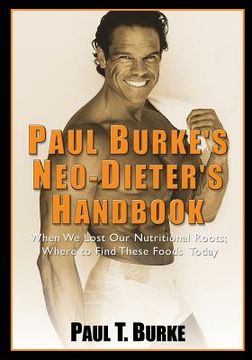Paul Burke's Neo-Dieter's Handbook: When We Lost Our Nutritional Roots; Where to Find These Foods Today. (en Inglés)
Reseña del libro "Paul Burke's Neo-Dieter's Handbook: When We Lost Our Nutritional Roots; Where to Find These Foods Today. (en Inglés)"
Paul Burke 's second book focuses on nutrition-three decades of research compiled for those who enjoy learning about health, exercise, weight training, fitness, and the right nutrition to enhance all of the above. This masterpiece of research, experience, and wisdom contains all-from the nutritional habits of prehistoric man to the "nutrition" of today's processed food. This book will answer such questions as: -Why should we stay away from chicken, pork, and beef if the animals are not pasture fed or not on a "non-grain" diet? -Why were mutant plants the source of present-day domesticated grains? -What are the numerous downfalls of animal domestication? -Why was every great human plague historically restricted to animals before jumping to humans? -Why did the Grist Mill change human longevity forever? -Why do doctors die at age 56-58 on average? -Why did pre-colonial Native Americans die of harsh weather or old age, but not disease? Burke takes the reader through the stages of human evolution with various indigenous cultures and their eating habits-from the massively muscled and healthy hunter-gatherers of 40,000 years ago to the culture of domesticated plants and animals. Burke's recommendations about the good and bad in his "Body Building Paleolithic Diet" may shock you, but the consequences of animal and plant domestication will shock you even more-things that neither the government nor family doctors talk about! After laying the evolutionary groundwork, Burke builds the anthropological/Paleonutritionolgy case for why one should not eat domesticated grains such as wheat and barely. About 40,000 years ago, the body no longer needed to organically change. Then, about 10,000 years ago, the last of the great Neo Paleolithians discovered something that would change everything-from what we ate to how wars were fought and why we colonized the New World. Plant and animal domestication robbed us of the great energy and power that wild plants and animals possess. In addition, the tenacious skills needed for hunting and gathering were lost-skills that made us the biggest, strongest, fastest, and most intuitive human beings of all time... LOST! The correlation between plant and animal domestication and diminishing human stature is striking. Within a few thousand years, we became a comparative skeleton. By the 16th-18th century, man was not much bigger than our chimpanzee ancestors averaging 5'6" and weighing 150 pounds-most of which was bones, organ tissue, and fat... lots of fat! Of course, the lifestyle of the hunter-gatherer made them strong and powerful, but more importantly, what they ate-wild animals, nuts, vegetables, and fruits-was the reason for their massive stature. Wild, wild, wild! The more an animal moves the more energy you get from it in the form of protein and carbohydrates as well as the "wild energy" stored in those tissues. A cow held fast in a metal harness all its life, only eating and defecating has no wild energy, very little life force. What you get on your plate is full of drugs and fat... lots and lots of fat! On the other hand, a wild deer, or one of the new "Free Range Buffalo," will give you protein and carbohydrates, in addition to that invisible, unquantifiable wild life force that made our great Neo Paleolithic ancestors such huge muscular marvels. The advent of the Grist Mill, spawned another industry-the research and treatment of cancer and diabetes. Our pancreas evolved to send out glucagon when protein was digested and insulin when carbohydrates and large amounts of fats where taken in. The mission: restore worked muscle tissue, replace organic tissue, and create fat. Back when we ate once a day at best, fat was used as fuel as soon as the glucose and stored glycogen was burned. Fast-forward to present day where we eat three meals of manufactured food and an absolute epidemic of diabetes is the result-Flour? Pasta? Bread? They are all forms of sugar! A lot of what we eat

